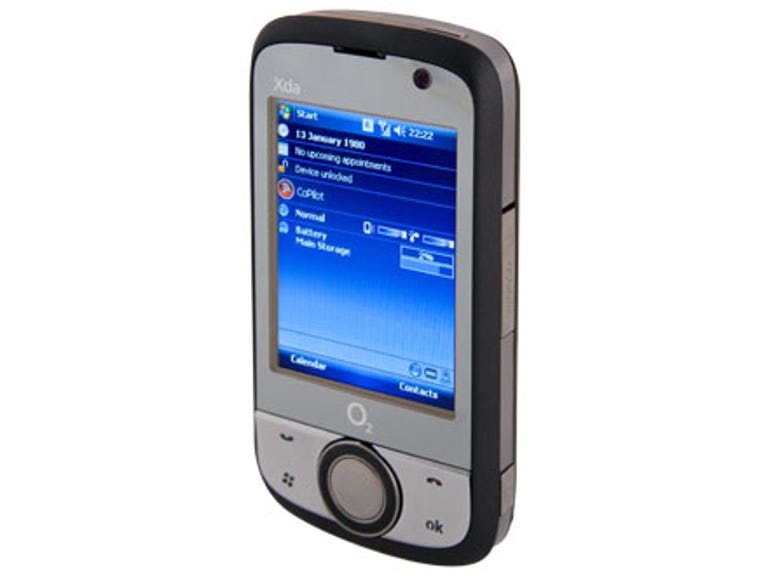 Why You Can Trust CNET
Why You Can Trust CNET O2 Xda Orbit 2 review: O2 Xda Orbit 2
The O2 Xda Orbit 2 may seem like business as usual, but it's a smart phone with oomph. Featuring HSDPA, Wi-Fi and Bluetooth, you get a plethora of connectivity options to keep in touch with the world. Throw in GPS for good measure, and you won't be lost either
The O2 Xda Orbit 2 is a rebranded version of the HTC Cruise, an all-in-one smart phone running Windows Mobile 6 Professional. It's also the successor to the original Orbit, which was the first Xda device to have built-in GPS.
The Good
The Bad
The Bottom Line
A year on, we don't find built-in GPS to be such a big deal anymore, so how does it stand up against the competition? We put it through the paces to find out. The O2 Xda Orbit 2 is currently available free on a monthly contract.
Design
Combining styling from the original Orbit and HTC Touch, the Orbit 2 is definitely a step in the right direction for O2's now sentence-cased Xda portfolio. It looks less like a business phone and more like something ripped off the inside of a BMW.

The Orbit 2's 71mm (2.8-inch) large screen makes viewing content enjoyable and is complemented by large, easy to press navigation and soft keys. The circular, four-way navigation key also doubles up as a scroll wheel, which is useful for searching through long lists. Another noteworthy design feature is the accessible microSD slot that allows you to slip in and out microSD cards with minimum hassle.
Aside from these design perks, the Orbit 2's design isn't much of an improvement on its predecessor. The handset has cleaned up nicely, so you won't be the laughing stock of your business meeting, but we'd like to see some panache substitute its chunkiness.
Features
There's no need to worry about connecting to the Internet if you're using an Orbit 2 -- it connects to almost everything. HSPDA (3.5G), Wi-Fi and Bluetooth mean that you're rarely going to be out of touch.
You won't be lost either: the Orbit 2 comes with CoPilot Live 7 sat-nav software. It's very capable at getting you from A to B without too much fiddling. The speakerphone is sufficiently loud enough to hear in a car, so you shouldn't miss a turn if you're paying attention.
Windows Mobile 6 Professional offers you all the Exchange email connectivity plus Microsoft Office editing and viewing capabilities that you'd expect, with 128MB SDRAM and a Qualcomm MSM7200 400MHz processor pushing it all along.
On the media side, there's an MP3 that supports a variety of formats and an FM radio. On the back, you'll find a 3-megapixel camera, which takes still pictures and videos. It seems a growing trend for handset manufacturers to leave off the LED photo light or xenon flash, and the Orbit 2 sadly follows along, making low-light photos impossible.
Similar to the HTC Touch, the Orbit 2 features the TouchFlo interface, which appears when you slide your finger up the screen. It gives you quick, finger-friendly access to contacts and selected apps, but is disappointing because it inevitably drops you back to the Windows Mobile interface, which isn't as touchy feely.
Performance
Audio quality during calls is fine without any noticeable distortion or muffling during calls. The loudspeaker is equally clear, which is good when using the Orbit 2 as a sat-nav.
As we mentioned, the 3-megapixel camera is really only good enough for MMS messages and -- at a push -- small prints. There's no light source on the phone, so keep your shooting to the sunshine.
We used the GPS in a car and found it worked, although in certain areas you may find you have to wait for several minutes before picking up any satellites.
Battery life is quoted at 4 hours talk time and 450 hours on standby. We found that battery life varied dramatically depending on how much we used HSDPA, GPS and Wi-Fi, but with moderate use, the Orbit 2 lasted for over two days.
Conclusion
While it still has an air of seriousness about it in comparison to phones like the Nokia N95 8GB, we really like the O2 Xda Orbit 2. It's business as usual on the inside but the plethora of connectivity options make it a great choice if you always need to keep in touch.
Our only word of warning would be that if you're used to a mechanical Qwerty keypad, then switching to a touchscreen might come as a shock -- try before you buy.
Edited by Jason Jenkins
Additional editing by Shannon Doubleday
